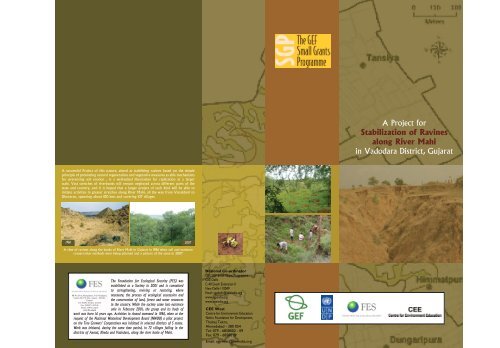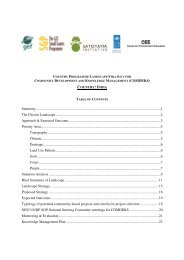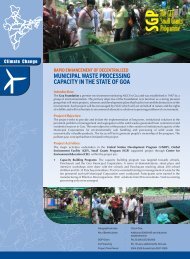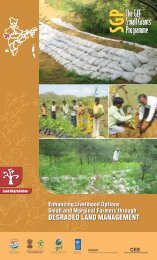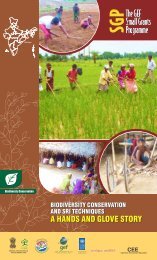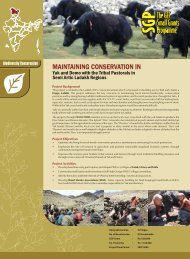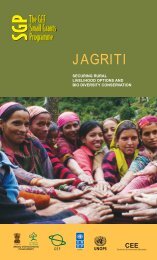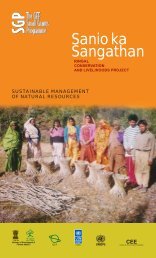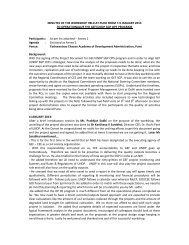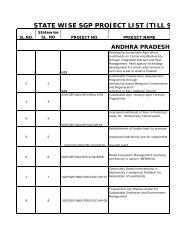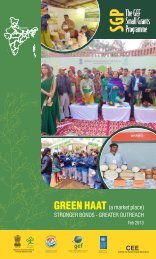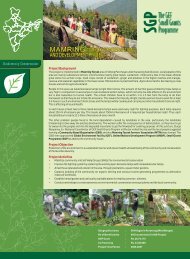A Project for Stabilization of Ravines along River - The GEF Small ...
A Project for Stabilization of Ravines along River - The GEF Small ...
A Project for Stabilization of Ravines along River - The GEF Small ...
- No tags were found...
Create successful ePaper yourself
Turn your PDF publications into a flip-book with our unique Google optimized e-Paper software.
A <strong>Project</strong> <strong>for</strong><br />
<strong>Stabilization</strong> <strong>of</strong> <strong>Ravines</strong><br />
<strong>along</strong> <strong>River</strong> Mahi<br />
in Vadodara District, Gujarat<br />
A successful <strong>Project</strong> <strong>of</strong> this nature, aimed at stabilizing ravines based on the simple<br />
principle <strong>of</strong> promoting natural regeneration and vegetative measures as able mechanisms<br />
<strong>for</strong> preventing soil erosion , is a well-suited illustration <strong>for</strong> replication at a larger<br />
scale. Vast stretches <strong>of</strong> riverbanks still remain neglected across different parts <strong>of</strong> the<br />
state and country, and it is hoped that a larger project <strong>of</strong> such kind will be able to<br />
initiate activities in greater stretches <strong>along</strong> <strong>River</strong> Mahi, all the way from Vanakbori to<br />
Dhuvaran, spanning about 100 kms and covering 107 villages.<br />
1986 2007<br />
A view <strong>of</strong> ravines <strong>along</strong> the banks <strong>of</strong> <strong>River</strong> Mahi in Gujarat in 1986 when soil and moisture<br />
conservation methods were being planned and a picture <strong>of</strong> the same in 2007<br />
,<br />
PB No.29 At:Jehangirpura, P.O. Gopalpura,<br />
Vadod-388 370, Dist. Anand – 388 001,<br />
Gujarat<br />
Tel: 02692-261402, 261238<br />
Fax: 262087 / 262196<br />
Email: ed@fes.org.in<br />
www.fes.org.in<br />
<strong>The</strong> Foundation <strong>for</strong> Ecological Security (FES) was<br />
established as a Society in 2001 and is committed<br />
to strengthening, reviving or restoring, where<br />
necessary, the process <strong>of</strong> ecological succession and<br />
the conservation <strong>of</strong> land, <strong>for</strong>est and water resources<br />
in the country. While the society came into existence<br />
only in Feburary 2001, the group and its body <strong>of</strong><br />
work was born 16 years ago. Activities in Anand stemmed in 1986, when at the<br />
request <strong>of</strong> the National Wasteland Development Board (NWDB) a pilot project<br />
on the Tree Growers’ Cooperatives was initiated in selected districts <strong>of</strong> 5 states.<br />
Work was initiated, during the same time period, in 72 villages falling in the<br />
districts <strong>of</strong> Anand, Kheda and Vadodara, <strong>along</strong> the river basin <strong>of</strong> Mahi.<br />
National Co-ordinator<br />
<strong>GEF</strong> SGP <strong>Small</strong> Grant Programme<br />
CEE Delhi<br />
C-40 South Extension-II<br />
New Delhi-110049<br />
Email: sgpdelhi@ceeindia.org<br />
www.sgpindia.org<br />
www.ceeindia.org<br />
CEE West<br />
Centre <strong>for</strong> Environment Education<br />
Nehru Foundation <strong>for</strong> Development,<br />
Thaltej Tekra,<br />
Ahmedabad - 380 054<br />
Tel: 079 - 6858002 - 09<br />
Fax: 079 - 6858010<br />
Email: sgpwest@ceeindia.org
ECOLOGICAL CONTEXT<br />
ACTIVITIES<br />
<strong>The</strong> <strong>River</strong> Mahi originates in Southern Rajasthan and passes<br />
through Panchmahals, Baroda, Kheda and Anand districts in the<br />
state <strong>of</strong> Gujarat and drains into the Arabian Sea at the Gulf <strong>of</strong><br />
Cambay. Even though the basin has a high density <strong>of</strong> trees and<br />
is characterized by rich biodiversity, an undulating topography<br />
coupled with loose and sandy to sandy-loam soil renders the the<br />
area highly susceptible to land degradation and erosion. <strong>The</strong><br />
absence <strong>of</strong> vegetative cover aggravates the situation, leading to<br />
the <strong>for</strong>mation <strong>of</strong> deep gullies and ravines on the commons and<br />
private land <strong>of</strong> the area. <strong>The</strong> embankments <strong>of</strong> 250-mile long river<br />
Mahi, is not an exception and is found to be severely ravined.<br />
<strong>Ravines</strong> not only impact the provisioning <strong>of</strong> ecosystem goods<br />
and services, such as food, fuel wood, fiber and water regulation<br />
services, they are also responsible <strong>for</strong> the loss <strong>of</strong> arable land<br />
which in turn threatens the livelihoods <strong>of</strong> the poorest farmers with<br />
marginal landholdings. A preliminary survey conducted in 107<br />
villages enfringing the river revealed that the ravines had affected<br />
no less than 30 thousand hectares <strong>of</strong> common as well as private<br />
land. <strong>The</strong> problem is further compounded on the common land<br />
<strong>of</strong> the villages as they are cared <strong>for</strong> by none and exploited by all.<br />
This happens due to lack <strong>of</strong> proper tenurial arrangements and<br />
absence <strong>of</strong> local institutions <strong>for</strong> managing common lands such<br />
grazing and revenue wastelands.<br />
PROJECT BACKGROUND<br />
With the objective <strong>of</strong> checking the further spread <strong>of</strong> ravines to<br />
prevent damage to the valuable tablelands and to work towards<br />
the stabilization <strong>of</strong> highly degraded and ravinous lands <strong>along</strong> river<br />
Mahi, a <strong>Project</strong> was initiated with assistance from Global Environment<br />
Facility (<strong>GEF</strong>), United Nations Development Programme<br />
(UNDP), <strong>Small</strong> Grants Programme (SGP) in 2005. <strong>The</strong> <strong>Project</strong> encompassed<br />
the villages <strong>of</strong> Himmatpura, Dungripura and Tansiya<br />
<strong>of</strong> Savli Taluka falling in Vadodara District; thereby bringing a total<br />
560 ha <strong>of</strong> degraded land, associated village communities and<br />
local institutions under its ambit.<br />
PROJECT OBJECTIVES<br />
Intervention during the <strong>Project</strong> period was primarily aimed<br />
at:<br />
Working towards restoration and stabilization<br />
<strong>of</strong> ravines <strong>along</strong> <strong>River</strong> Mahi through appropriate soil and<br />
water conservation measures and improved vegetative<br />
cover<br />
FES, Anand <strong>Project</strong> Area<br />
Districtwise distribution <strong>of</strong> Mahi ravinous areas from<br />
Vanakbori to Dhuvaran<br />
Ravination <strong>along</strong> the <strong>River</strong> Mahi is spreading both vertically and<br />
horizontally, at large scale considered only second to that <strong>of</strong> the<br />
Chambal ravines.<br />
Boribandhs are harvesting rain water and producing a conducive<br />
micro climate <strong>for</strong> vegetative growth.<br />
Appropriate soil conservation measures have succeeded in<br />
reducing soil erosion and have effected an increase in silt<br />
accumulation<br />
Three local village level institutions in the nature <strong>of</strong> Tree Grower’s<br />
Cooperative Societies were strengthened by helping them secure<br />
tenure over the land in the <strong>for</strong>m <strong>of</strong> long term lease and laying<br />
emphasis on the principle <strong>of</strong> universal membership and by ensuring<br />
the inclusion <strong>of</strong> women and marginalized sections.<br />
Groups <strong>of</strong> community members were trained and capacitated to<br />
undertake perspective planning and assist in GIS-based mapping<br />
exercises. Ecological restoration plans and treatment plans were<br />
drawn using participatory tools and techniques.<br />
A total <strong>of</strong> 74 training programs and meetings were conducted <strong>for</strong><br />
capacity building <strong>of</strong> the community, in which 1532 odd members<br />
consisting <strong>of</strong> no less than 397 women members participated.<br />
All the 3 TGCSs were assisted in framing village specific byelaws <strong>for</strong><br />
protection and benefit sharing <strong>of</strong> resources.<br />
Considering the abundance <strong>of</strong> sandy-loam soil in the affected areas,<br />
boribandh or sand bag structures were used to plug gullies in 102<br />
ha <strong>of</strong> common land. 275 ha. <strong>of</strong> private land was also treated through<br />
farm bunding.<br />
85,758 saplings <strong>of</strong> 12 tree species were raised in 6 decentralised<br />
nurseries in three villages <strong>of</strong> the project area. Total contribution by<br />
the members in raising the saplings amounted to Rs. 22,342 (25%).<br />
Regeneration activities were undertaken in 102 ha <strong>of</strong> Common<br />
land, which included planting <strong>of</strong> 49,371 saplings <strong>of</strong> 18 tree species,<br />
dibbling <strong>of</strong> 946 kg <strong>of</strong> seeds <strong>of</strong> 21 tree species, 99.5 kg <strong>of</strong> grass seeds<br />
and 8,300 root slips <strong>of</strong> three grass species. Community contributions<br />
towards regeneration activities amounted to Rs. 88,611 (33%).<br />
A total <strong>of</strong> 31,121 saplings were planted on farm bunds , in which the<br />
contribution by the members was Rs. 3,56,895 (33%).<br />
In collaboration with Gujarat Land Development Corporation (GLDC),<br />
farm bunding and leveling was undertaken in 225 ha <strong>of</strong> farm land.<br />
Installation <strong>of</strong> energy efficient devices was undertaken to reduce<br />
pressure on regenerated biomass. A total <strong>of</strong> 86 smokeless chulhas<br />
were installed. Sixty pressure cookers were also distributed amongst<br />
the local community members, the community contribution towards<br />
which was to the effect <strong>of</strong> Rs 24,382 (50%)<br />
OUTCOMES<br />
Drainage line treatment has controlled run-<strong>of</strong>f and accumulated silt<br />
in the gullies.<strong>The</strong> total silt trapped by the check dams amounts to 26<br />
tonnes/ha over a total treated area <strong>of</strong> 102 Ha.<br />
Strengthening tenure arrangements and village<br />
institutions in the nature <strong>of</strong> Tree Growers’ Cooperatives,<br />
with the intention <strong>of</strong> improving the governance <strong>of</strong> natural<br />
resources and ensuring the stabilization <strong>of</strong> the ravine<br />
lands<br />
UNDP SGP <strong>Project</strong><br />
Facilitating the involvement <strong>of</strong> the local communities in planning<br />
and incorporating local wisdom at the initial stage leads to better<br />
understanding and implementation <strong>of</strong> the project by them.<br />
Natural regeneration has improved significantly with community<br />
protection and has in turn led to a substantial reduction in soil<br />
erosion. Enrichment seeding and planting have shown survival rates<br />
<strong>of</strong> as much as 40%.<br />
Soil erosion <strong>of</strong> farm lands has been controlled due to farm bunding<br />
and vegetative measures.<br />
ACTION PLAN FOR RAVINE RECLAMATION<br />
Aiding revegetation with help <strong>of</strong><br />
Mechanical and Vegetative Control Structures<br />
<strong>The</strong> communities have successfully evolved regulation mechanisms<br />
<strong>for</strong> protecting the common lands. Though collection <strong>of</strong> dry wood and<br />
twigs <strong>for</strong> satisfying local energy requirements, green felling is totally<br />
banned .<br />
MECHANICAL CONTROL<br />
STRUCTURES<br />
Reduce Velocity Of<br />
Flow <strong>of</strong> water<br />
Check Erosion<br />
Increase Local<br />
Moisture Regime<br />
Provide conducive<br />
environment For<br />
Natural Regeneration<br />
VEGETATIVE CONTROL<br />
STRUCTURES<br />
Improve soil binding<br />
as well as soil quality<br />
Check Erosion<br />
Create microhabitats<br />
<strong>for</strong> associate species<br />
Provides conducive<br />
environment <strong>for</strong><br />
succession<br />
Diagram <strong>of</strong> model plot:<br />
Ridge to Valley treatment <strong>for</strong> ravines is a<br />
tried and tested approach to check land<br />
degradation.<br />
In Dungripura, Smt. Kapilaben Vikrambhai Bhoi<br />
successfully raised and managed a nursery in the<br />
year 2006 with project assistance. She raised a<br />
total 10,000 saplings <strong>of</strong> six species, namely-Desi<br />
Babul, Ardusa, Kanaj, Kothi, Jamun, and Amla.<br />
She made a net pr<strong>of</strong>it <strong>of</strong> Rs. 5,000, which was<br />
invested in an insurance policy <strong>for</strong> the family and<br />
in affecting timely repairs to a flourmill being<br />
operated by her household.<br />
It is estimated that energy conservation measures have reduced<br />
fuelwood requirement <strong>of</strong> the communities by at least 10%.<br />
A total number <strong>of</strong> 6,896 person days <strong>of</strong> labour was generated as<br />
part <strong>of</strong> project activities and local communities were benefited by<br />
Rs. 5,68,878.<br />
Women members took the lead in raising and managing decentralised<br />
nurseries at the village level, thereby ensuring ready availability <strong>of</strong><br />
saplings at the onset <strong>of</strong> monsoons. Interested participants were<br />
trained in the basics <strong>of</strong> bed preparation, watering, seed treatment,<br />
manure application, bag filling, weeding, hoeing, shifting, grading,<br />
hardening, pest and disease management, transportation <strong>of</strong> saplings<br />
and transplantation <strong>for</strong> this purpose. A total <strong>of</strong> 6 nurseries were raised<br />
in this manner, totalling the number <strong>of</strong> saplings to 85,758.


